|
|
|
Fateful
Date
![]()
”What does Hawaii mean to you?" Diamond Head and Waikiki, hula girls and palm trees, surfers and sunsets… - to some it meant Pearl Harbor!
A few days after its arrival the Squadron was hard at work and five towing missions alone were rendered on June 25, 1940. This high ratio was continued until December 7, 1941.
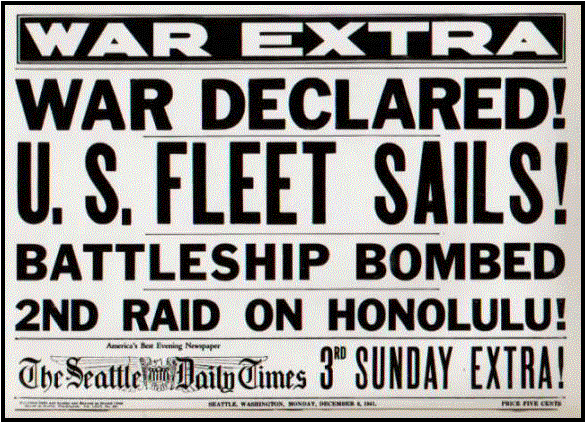
In
a matter or minutes after the first alarm, on the morning of December 7, Utility
Squadron One personnel had J2F amphibious planes, with machine guns mounted in
the second cockpits, turned against the enemy, regardless of personal danger to
themselves. Other 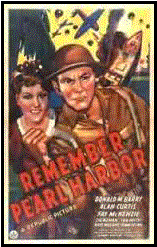 personnel
used rifles against the enemy, while still others gave aid to
the Injured, heedless of bursting bombs. The Japanese, scorning attack on
Utility Planes, painted- green and orange, left them unharmed: and it was in
these unarmed planes that Utility Pilots took off at 0950 in the midst of enemy
action, to take up search for source of the attack. Some of the crew's grabbed
rifles to take with them in the planes every available plane of Uti1lty Squadron
One took off foe search and observation, in flights ranging from six to eight
hours Utility Squadron One’s "Base Radio took over radio communication
when other facilities
were damaged beyond repair. It is believed that one of VJ-1's planes piloted by
Lt. W. Ruth and Lt. R. C. Geise, present executive officer of the Squadron, was
the first Naval plane to
personnel
used rifles against the enemy, while still others gave aid to
the Injured, heedless of bursting bombs. The Japanese, scorning attack on
Utility Planes, painted- green and orange, left them unharmed: and it was in
these unarmed planes that Utility Pilots took off at 0950 in the midst of enemy
action, to take up search for source of the attack. Some of the crew's grabbed
rifles to take with them in the planes every available plane of Uti1lty Squadron
One took off foe search and observation, in flights ranging from six to eight
hours Utility Squadron One’s "Base Radio took over radio communication
when other facilities
were damaged beyond repair. It is believed that one of VJ-1's planes piloted by
Lt. W. Ruth and Lt. R. C. Geise, present executive officer of the Squadron, was
the first Naval plane to  contact Japanese aircraft in the air. If this same
plane had been able to continue its search for 30 miles further it would have
most probably located elements of the main Japanese fleet. For many days after
the attack every available Utility plane was used for search and patrol,
regardless of armament. For their heroic and daring exploits during and
following the enemy attacks many of the personnel of Utility Squadron One
received Navy Crosses and commendations. (circa 1945) Note. Click on radio image
to hear broadcast announcing attack on Pearl Harbor.
contact Japanese aircraft in the air. If this same
plane had been able to continue its search for 30 miles further it would have
most probably located elements of the main Japanese fleet. For many days after
the attack every available Utility plane was used for search and patrol,
regardless of armament. For their heroic and daring exploits during and
following the enemy attacks many of the personnel of Utility Squadron One
received Navy Crosses and commendations. (circa 1945) Note. Click on radio image
to hear broadcast announcing attack on Pearl Harbor.
MISCELLANEOUS PEARL HARBOR PHOTOS
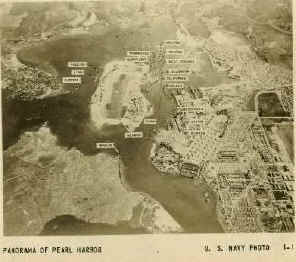 |
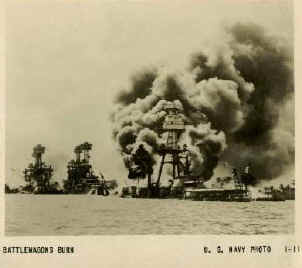 |
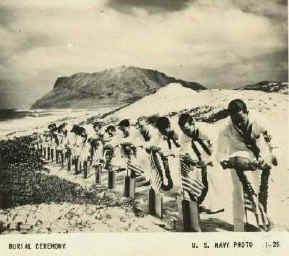 |
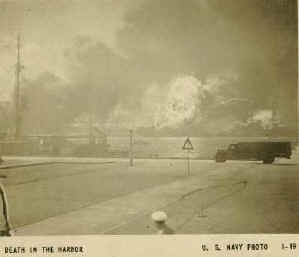 |
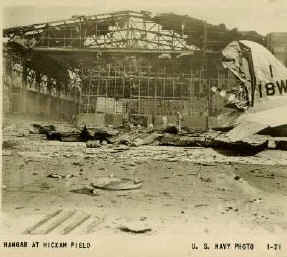 |
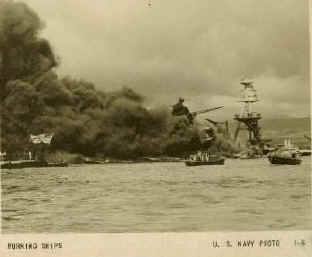 |
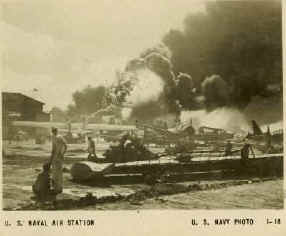 |
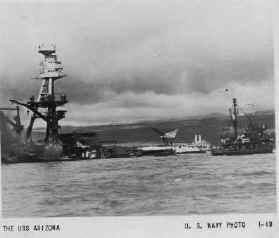 |
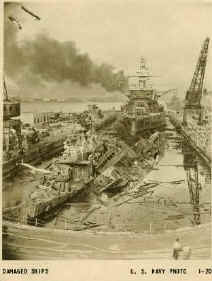 |
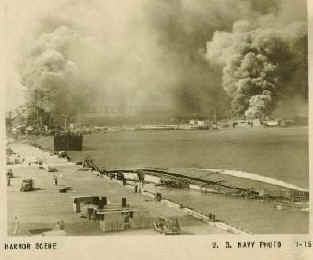 |
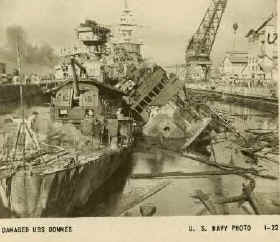 |
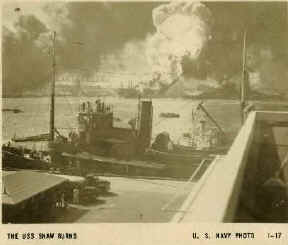 |
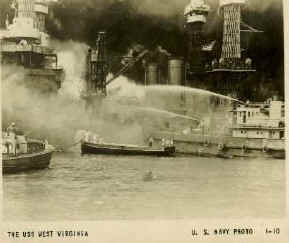 |
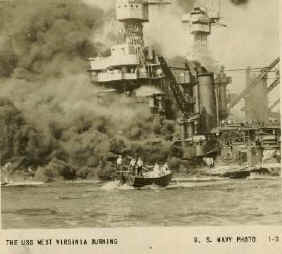 |
![]()
|
MOFFET
FIELD 1944-45 |
WESLEY HOYT RUTH |
|
|
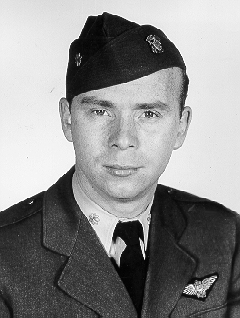
Service Dates
|
I piloted one of the first JRS aircraft to take-off of Ford Island after
the second Jap attack. I was an Ensign at the time. We had been carrying
depth charges on our JRS aircraft a few months before Dec. 7th. I first
saw the Jap aircraft over Ford Island while having breakfast in our BOQ.
and thought they were one of our carrier groups practicing a mock attack
- until I saw them dropping bombs on the PBY aircraft and hangars. I had
the duty so I drove around the N end of the runway from the BOQ to the
Utility Squadron One hangar amid ship on the east side of the single
runway. As I drove along the eastern side of the runway powder pellets
were falling from the exploding ships. After parking my car under some
trees, I ran into our hangar. I was the only officer there with just a
few enlisted men. Our 12 JRS aircraft were parked between the hangar and
the runway. None of them were damaged during the attacks. We were a
non-combat squadron. The only guns I ever saw were the three issued to
three of my crewman. My co-pilot was 'Pappy' Guise, an enlisted pilot, a
radioman and the three crewman with the three Springfield rifles. Our
search for the Jap Fleet was to fly N 250 miles, turn right and fly E
for 10 miles and then to turn right and return to Ford Island. I learned
later that the Jap Fleet had come in from due N of Oahu to a point 160
miles N of Oahu where they launched their aircraft and then turned NW to
recover their aircraft when they returned from the attacks. The flight
was uneventful until we got a few miles N of Oahu when one of the
crewman reported a single engine plane behind us. I dove the plane down
to just above the waves to give our crewman the best opportunity to
shoot at the plane if we were attacked. The plane turned away. I have
never learned whether it was one of about six Jap  aircraft that had been
damaged and couldn't make it back to their carriers or one of our search
planes. We landed and reported the results of our flight. For that
afternoon and the next few days we were hearing radio reports of troops
landing on different parts of Oahu which proved to be false reports. I
never did hear who was controlling the radio for those reports. I was
awarded the Navy Cross for the flight. Our Squadron was the Pacific
Fleet Photographic Squadron and when the attacks occurred our
photographers went into action and photographed many of the scenes we
have seen in the media. Full details of the disaster were authored in
the book "And I Was There" by the Intelligence Officer for
Admiral Kimmel (Adm. Edwin T. Layton)40 years after Dec.7, 1941, when
the info was declassified. aircraft that had been
damaged and couldn't make it back to their carriers or one of our search
planes. We landed and reported the results of our flight. For that
afternoon and the next few days we were hearing radio reports of troops
landing on different parts of Oahu which proved to be false reports. I
never did hear who was controlling the radio for those reports. I was
awarded the Navy Cross for the flight. Our Squadron was the Pacific
Fleet Photographic Squadron and when the attacks occurred our
photographers went into action and photographed many of the scenes we
have seen in the media. Full details of the disaster were authored in
the book "And I Was There" by the Intelligence Officer for
Admiral Kimmel (Adm. Edwin T. Layton)40 years after Dec.7, 1941, when
the info was declassified.
Wesely Hoyt Ruth |
|
![]()
HARRY R. MEAD
Radioman Second Class Harry R. Mead, USN - Second Class Mead, "although aware that his post in the Naval Station, Ford Island would be a major enemy target and all other personnel were ordered to shelter, stayed at his post throughout the attack. He also volunteered as radioman-gunner in a plane assigned to a search mission."
http://my.execpc.com/~dschaaf/mead.html
VJ-1 at Pearl Harbor
|
|
|
|
|
|
Majuro Atoll
Majuro Atoll, is a part of the Marshall Island group, and
includes the capital "city" of Majuro. For those who may not be
familiar with the term, an "atoll" is basically a group of flat
islands linked together by a coral reef. In the case of Majuro Atoll, the chain
of islands and coral reefs is about 30 miles long, but less than a mile wide at
its very widest. In December 1943 the population of Majuro was less than 800 and
the atoll a quiet spot. U.S. Intelligence had photographed Majuro Atoll and had
found a Japanese military installation at its eastern end. Given what was known
at the time, the U.S. Forces assumed that the sea-plane base was still
operational.

In 1944 a temporary VJ-1A was set up at Majuro Atoll in the Marshal Island. Majuro Atoll, is a
part of the Marshall Island group, and includes the capital “city” of Majuro.
|
|
|
|
|
|
|
|
|
In April the detachment of VJ-1A
at Majuro used JM’s Martin Marauders painted chrome yellow and stripped down
for towing to provided towing for the fleet staging there for the Guam push.
Detachment relieved by VJ-17 end of June
and returned to Pearl.
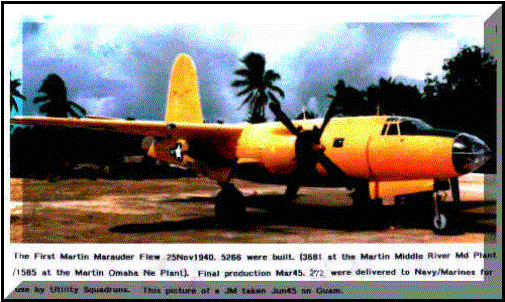
The Squadron embarked on the USS
Block Island 19Oct45 for return to Pearl. After
VJ Day we folded our operation and returned to NAS Moffett Field, California.
VJ-1 relieved at Pearl Harbor on July 31, 1944 and embarked on the USS Bismarck
Sea for NAS Point Mugu, California reporting back for duty at NAS Moffett Field,
California September 6S 1944 relieving VJ-18. Our primary missson was towing for
fleet gunnery school at a NAS Point Mugu, California & Marine Gunney School.
The two Block Island (CVE 21 and CVE 106) Aircraft
Carriers were unlike any other two ships by the same name.
CVE 21 (along with 5 other CVE’s)
was originally actually a C3 tanker hull being constructed to deliver oil
to our allies in Europe.
The world of USS Block Island CVE-106 was very different than that of
CVE-21. Since this ship is just a hunk of cold steel and must have a crew
to provide the heart and soul. In the circumstances surrounding these two ships
the majority of the crews were the same “heart and soul” of both ships. This
circumstance also put these crew members in another world. The
picture above shows only six of the 7 aircraft carriers that were a part of the
CVE 106 task force. The picture also does not show the some fifty escort or
service ships that were also a part of the force. Not one single day
went by where no other ships were in sight. By the time CVE 106 went to
fighting duty the Navy had fairly well taken care of the Japanese submarine
force. CVE
106 and
the crew had to defend against enemy surface vessels, enemy aircraft and even
other enemy surface vessels. The aircrews and pilots had to defend and attack
enemy aircraft, ships, land based guns, and at the same time provide protection
to the allied troops undertaking the task of retaking the island from the
Japanese. Along with their new US Marine counterparts, the entire crew of CVE
106 proved that the only thing that really changed was the circumstances that
was presented in this new world.
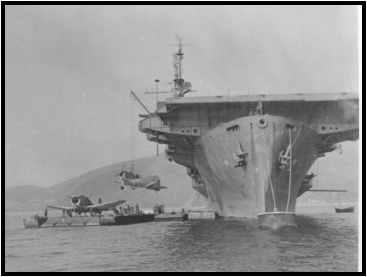
![[IMAGE]](images/majuro18.gif) The
U.S.S. Bismarck Sea was the last American aircraft carrier sunk in World War II.
It was sunk 21 February 1945 during a kamikaze attack after sunset at the battle
for Iwo Jima with a loss of 318 men from ship's company and composite squadron
VC86.BISMARCK SEA was
launched 17 April 1944 by Kaiser Co., Inc., Vancouver, Wash., under a Maritime
Commission contract as ALIKULA BAY; sponsored by Mrs. M. C. Wallgren, wife of
Senator Wallgren; renamed BISMARCK SEA 16 May 1944; transferred to the Navy 20
May 1944; and commissioned the same day, Captain J. L. Pratt in command. During
July and August 1944 BISMARCK SEA escorted convoys between San Diego, Calif.,
and the Marshall Islands. After repairs and additional training at San Diego,
she steamed to Ulithi, Caroline Islands, to join the 7th Fleet. During 14-23
November 1944 she operated off Leyte in support of operations there.
The
U.S.S. Bismarck Sea was the last American aircraft carrier sunk in World War II.
It was sunk 21 February 1945 during a kamikaze attack after sunset at the battle
for Iwo Jima with a loss of 318 men from ship's company and composite squadron
VC86.BISMARCK SEA was
launched 17 April 1944 by Kaiser Co., Inc., Vancouver, Wash., under a Maritime
Commission contract as ALIKULA BAY; sponsored by Mrs. M. C. Wallgren, wife of
Senator Wallgren; renamed BISMARCK SEA 16 May 1944; transferred to the Navy 20
May 1944; and commissioned the same day, Captain J. L. Pratt in command. During
July and August 1944 BISMARCK SEA escorted convoys between San Diego, Calif.,
and the Marshall Islands. After repairs and additional training at San Diego,
she steamed to Ulithi, Caroline Islands, to join the 7th Fleet. During 14-23
November 1944 she operated off Leyte in support of operations there.
The planes to be found in a glance around the Utility Hangars are the JRS-1s, the new twin-engined Sikorskies, Grumman single-engined amphibians, Douglas Dolphin Amphibs and Wall Patrol Planes.” “Throughout the turbulent months of cooperation with the Fleet there has been a growing demand for “new practices”, “a new towing service”, “a new photographic assignment”, “a new night anti-aircraft practice”, all of which have furnished constant problems and headaches in planned performance and personnel output. The increasing demand for these new practices has not eliminated previous problems, but has added to them.
|
|
|
|
|
|
|
|
|
VJ-1
OFFICERS
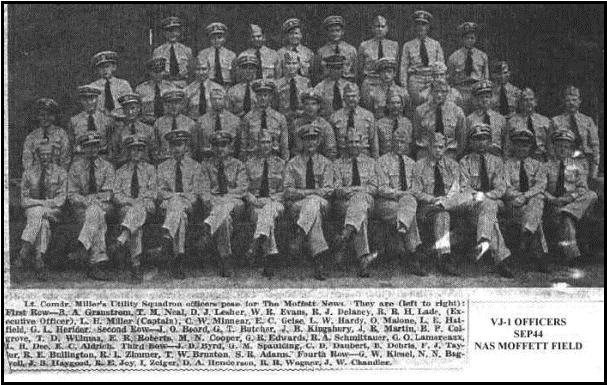
|
Utility Squadron One Arrives At Moffett After Four Years at Pearl Harbor Enjoys Well-Earned Shore Duty Tour By LT. E. C. ALDRICH The Utility Squadron which recently arrived on this Station is enjoying a well earned tour of "stateside" duty after being more four years at Pearl Harbor. Many of the officers and men in this squadron have spent the entire time since the Pearl Harbor attack in the same location overseas, and it can be imagined the impatience with which awaited return to their families, many of whom they had not seen for more than three years. This squadron has long "firsts, to its credit in
the field of Utility Aviation A few minutes after the first attack on Ford Island, Pearl Harbor, the squadron set up an emergency defense position. For this JF2 amphibians were placed in various positions on the field and machine guns mounted on the rear cockpit brought to bear on the Japanese planes. Shortly after the first attack eight slow; antiquated JRS Utility amphibians took off in the midst of enemy to search for the source of the carrier attack; none of these planes was lost. Certainly, had they located the carriers on that fateful day, the offensive action of the Jap Navy in the Hawaiian area would have been changed. Also, had the fleet been located, it would have been "curtains" for the utility pilots, and crews for we planes only" protection was automatic shotguns and rifles! Five Navy Crosses and eleven commendations have been awarded for the thoroughness with which they executed these hazardous missions. together with the operation of ‘an emergency base radio.’ For. two and one-half years after December 7 daily search hops at; sea in search of enemy task forces were made by this squadron. To describe the duties of a Utility Squadron is
difficult, for they are Other important flying services are experimental flights for special devices training units, convoying of ships, and rescue mission, convoying of ships and rescue missions. The Moffett News (Vol. II, No. 20) |
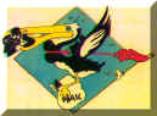
A Navy wide reorganization of its aviation units caused a 15 November 1946 redesignation of VJ-1 to VU-1. However, postwar reductions forced the disestablishment of the squadron on 30 April 1949.
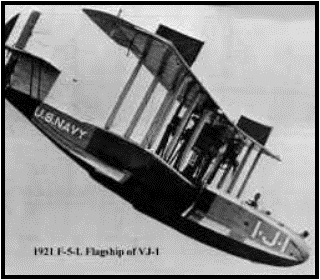
|
Link to "The Pearl Harbor History Associates" |